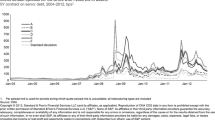Abstract
In this study we investigate why tax-exempt money market mutual funds often waive fees. Contrary to statements in the popular press, our results provide weak evidence that fee waivers lead to asset growth. We find strong evidence, however, that fee waivers are used to keep the fund’s reported yield in line with competitors. We find that funds have comparable before-expense yields and that smaller funds generally have higher expenses. If all expenses were charged to investors, then smaller funds would significantly underperform larger funds. Thus, in order to keep reported yields in line with competitors, smaller funds must waive a significant portion of fees.(JEL G20, G21)
Similar content being viewed by others
References
Clark, S. L., F. R. Foundos, and M. C. Lee. 1996. “Rule 2a-7 and Other 1996 Rule Changes Affecting Money Market Funds.”Municipal Finance Journal 17(3): 63–77.
Collins, S. S., and P. R. Mack. 1994. “Avoiding Runs in Money Market Mutual Funds: Have Regulatory Reforms Reduced the Potential for a Crash?.”Finance and Economics Discussion Series 94(14): 1–19.
Crabbe, L., and M. A. Post. 1992. “The Effect of SEC Amendments to Rule 2a-7 on the Commercial Paper Market.”Finance and Economics Discussion Series 199: 1–28.
Damato, K. 1999. “No Free Lunch: Fee Waivers at Money Funds Are Fleeting.”Wall Street Journal (October 15): C1.
DeGennaro, R. P., and D. L. Domian. 1996. “Market Efficiency and Money Market Fund Portfolio Managers: Beliefs Versus Reality.”The Financial Review 31: 453–474.
Farinella, J. A., and T. W. Koch. 1999. “The Demand for Taxable and Tax-Exempt Money Market Mutual Funds.”Journal of Macroeconomics 2: 335–353.
Farinella, J. A., and T. W. Koch. 2000. “Seasonal Patterns in Money Market Mutual Funds.”Review of Quantitative Finance and Accounting 14: 261–276.
Farinella, J. A., and R. D. Jorgensen. 1998. “Tax-Exempt Money Market Mutual Funds: Regulation, Risk and Return.”Journal of Accounting and Finance Research 5: 50–59.
Farinella, J. A., and R. D. Jorgensen. 1999. “The Management of Short-Term Interest Rate Risk in Tax-Exempt Money Market Mutual Funds.”Journal of Accounting and Finance Research 7: 75–82.
Farrar, D. E., and R. E. Davis. 1991. “The Optimal Time to Impose Normal Operating Expenses on Newly Organized Money Market Funds: When Should You Cut the Tree?”Financial Analysts Journal 47: 80–84.
Lam, C. H., R. Deb, and T. Fomby. 1984. “Deregulation and the Demand for Money Market Mutual Funds.”Journal of Macroeconomics 11: 297–308.
Permut, S., S. A. Keen, and S. Zenoble. 1995. “Tax-Exempt Money Funds: Learning to Live with Rule 2a-7.”Municipal Finance Journal 15(4): 60–75.
Author information
Authors and Affiliations
Rights and permissions
About this article
Cite this article
Farinella, J.A., Jorgensen, R.D. Fee waivers for tax-exempt money market mutual funds. J Econ Finan 26, 31–49 (2002). https://doi.org/10.1007/BF02744450
Issue Date:
DOI: https://doi.org/10.1007/BF02744450



